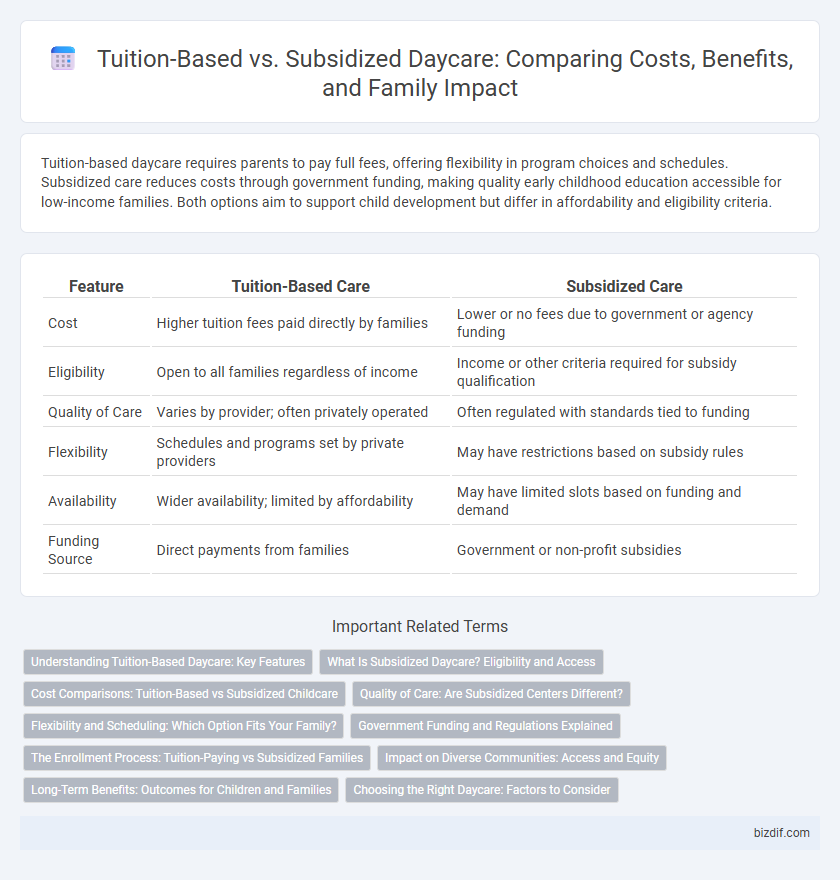Tuition-based daycare requires parents to pay full fees, offering flexibility in program choices and schedules. Subsidized care reduces costs through government funding, making quality early childhood education accessible for low-income families. Both options aim to support child development but differ in affordability and eligibility criteria.
Table of Comparison
| Feature | Tuition-Based Care | Subsidized Care |
|---|---|---|
| Cost | Higher tuition fees paid directly by families | Lower or no fees due to government or agency funding |
| Eligibility | Open to all families regardless of income | Income or other criteria required for subsidy qualification |
| Quality of Care | Varies by provider; often privately operated | Often regulated with standards tied to funding |
| Flexibility | Schedules and programs set by private providers | May have restrictions based on subsidy rules |
| Availability | Wider availability; limited by affordability | May have limited slots based on funding and demand |
| Funding Source | Direct payments from families | Government or non-profit subsidies |
Understanding Tuition-Based Daycare: Key Features
Tuition-based daycare requires families to pay a set fee for childcare services, often reflecting the program's quality, location, and staff qualifications. These centers typically offer flexible scheduling, enriched curricula, and smaller child-to-caregiver ratios to enhance developmental support. Understanding the cost structure and included services helps parents make informed decisions between tuition-based and subsidized care options.
What Is Subsidized Daycare? Eligibility and Access
Subsidized daycare provides affordable childcare by lowering or covering tuition costs through government programs aimed at low-income families, enhancing access to quality early education. Eligibility for subsidized care varies by state and typically considers family income, employment status, and children's ages, with priority given to families facing financial hardships. Access to these programs often requires completing an application through local agencies or social service offices that manage childcare subsidies and support services.
Cost Comparisons: Tuition-Based vs Subsidized Childcare
Tuition-based childcare often requires families to pay full market rates, which can range from $200 to $1,000 per week depending on location and program quality. Subsidized childcare reduces out-of-pocket expenses through government funding or assistance programs, lowering costs to as little as $50 per week for eligible families. Cost comparisons reveal that subsidized care can significantly ease financial burdens, making early childhood education more accessible for low- and moderate-income households.
Quality of Care: Are Subsidized Centers Different?
Tuition-based daycare centers often have more resources to invest in smaller class sizes, specialized staff training, and enriched learning materials, which can enhance the quality of care. Subsidized centers may face funding constraints that affect staffing ratios and facility upkeep, but many adhere to strict state regulations ensuring baseline quality standards. Research indicates that while tuition-based centers generally offer more varied enrichment programs, subsidized care maintains comparable safety and developmental support for children.
Flexibility and Scheduling: Which Option Fits Your Family?
Tuition-based daycare offers greater flexibility in scheduling, allowing parents to select hours that directly meet their family's unique needs, including extended or irregular times. Subsidized care typically follows fixed hours tied to funding guidelines, which may limit options for families with non-traditional work schedules. Choosing between these options depends on your requirements for flexible access versus cost-saving benefits through government support.
Government Funding and Regulations Explained
Tuition-based daycare relies primarily on parent fees and minimal government funding, leading to variable costs and flexible service options. Subsidized care is funded significantly by government programs, reducing financial barriers for low-income families through strict eligibility criteria and income limits. Regulations for subsidized providers are often more rigorous, ensuring compliance with safety, quality standards, and accountability tied to public funds.
The Enrollment Process: Tuition-Paying vs Subsidized Families
Tuition-based daycare enrollment typically requires families to provide proof of income, complete an application, and pay fees upfront or via a payment plan, ensuring immediate access to care. Subsidized care enrollment involves verifying eligibility through income thresholds or government assistance programs, followed by a more extensive documentation review and sometimes longer wait times due to funding limits. Both processes aim to prioritize child placement but differ significantly in financial verification and administrative requirements.
Impact on Diverse Communities: Access and Equity
Tuition-based daycare often limits access for low-income families, exacerbating disparities in early childhood education and hindering equitable development opportunities for diverse communities. Subsidized care programs increase accessibility by lowering financial barriers, promoting inclusivity and improved outcomes for children from marginalized backgrounds. The availability and quality of subsidized care directly influence social equity and long-term academic success across socioeconomic groups.
Long-Term Benefits: Outcomes for Children and Families
Tuition-based daycare often provides higher-quality resources and individualized attention, leading to better cognitive and social development outcomes for children. Subsidized care increases accessibility for low-income families, reducing financial stress and promoting family stability over time. Both models support long-term benefits by fostering early childhood education and contributing to improved academic achievement and economic opportunities.
Choosing the Right Daycare: Factors to Consider
Tuition-based daycare often offers more flexible hours and specialized programs, while subsidized care provides affordable options for families meeting income requirements. Consider factors such as cost, program quality, staff qualifications, location, and availability of financial aid when selecting a daycare. Evaluating these elements ensures a balance between budget constraints and the child's developmental needs.
Tuition-based vs Subsidized care Infographic

 bizdif.com
bizdif.com